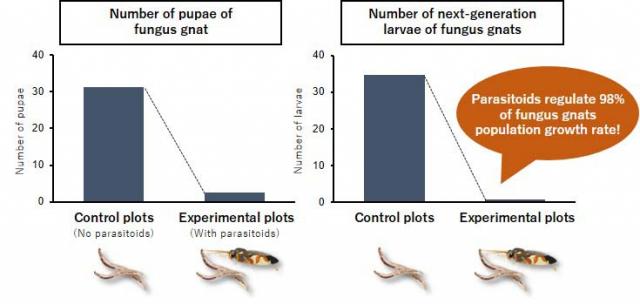Home > Research > Research Results > Research Results 2019 > Newly discovered natural enemy of shiitake pests —Wasps prey on fungus gnats, endangering shiitake mushroom cultivation
Update:July 1, 2019
Main content starts here.
Newly discovered natural enemy of shiitake pests —Wasps prey on fungus gnats, endangering shiitake mushroom cultivation
| Article title |
Parasitoid wasps regulate population growth of fungus gnats genus Neoempheria Osten Sacken (Diptera: Mycetophilidae) in shiitake mushroom cultivation |
|---|---|
| Author (affiliation) |
Hiromi Mukai(a), Hiroshi Kitajima(a) (a) Department of Forest Entomology, FFPRI, Tsukuba, Ibaraki, Japan. |
| Publication Journal | Biological Control, 134;15-22, July 2019 DOI:10.1016/j.biocontrol.2019.03.016( External link ) |
| Content introduction |
The annual production of mushroom cultivation accounts for half of the entire production in the lumber and forestry industry in terms of monetary value. In particular, shiitake mushroom is a valuable commodity, accounting for 30% of the production of cultivated mushrooms. In recent years, shiitake has been increasingly produced using sawdust-based mycelial block cultivation; however, their commodity value has been seriously threatened by insect pests. Fungus gnats of the genus Neoempheria eat and reproduce on these mycelial blocks and shiitake, resulting in instances of mushrooms being sold with larvae attached. Therefore, they are considered as a serious nuisance. The Forestry and Forest Products Research Institute (FFPRI) has been researching biocontrol technology to exterminate shiitake pests by harnessing their natural enemies. We collected larvae of fungus gnats from cultivation houses owned by farmers in the Kanto region. After transporting the samples back to our facility and growing them, we found that imagoes of wasps, instead of fungus gnats, emerged from pupae. In a batch of samples collected from a certain cultivation house, more than 60% of the pupal samples hatched into adult wasps. We observed in our laboratory that a parasitoid wasp swiftly approached a detected fungus gnat larva, stung the larva, and oviposited into its bodies (Figure1). The hatched larva of the parasitoid wasp then grew by feeding on the fungus gnat larva, eventually killing the host and becoming an imago. Based on detailed examination, these parasitoid wasps were identified with a high likelihood to be a new species of the subfamily Orthocentrinae. Next, we simultaneously released larvae of fungus gnat and adults of parasitoid wasp into an experimental cultivation house owned by FFPRI. Subsequently, we confirmed a marked decrease in the number of fungus gnat larvae that grew into pupae when parasitoid wasps were also released. Further continued observation indicated that the number of next-generation fungus gnat larvae drastically declined, indicating an effect to suppress the larval population growth by approximately 98% (Figure2). With the number of fungus gnat pupae reduced, the number of reproductive imagoes also decreased, thereby resulting in a precipitous decline in the number of next-generation fungus gnat larvae. These results demonstrate that these parasitoid wasps are highly effective in suppressing the population growth of fungus gnats within cultivation houses. In future research, we aim to develop a new biocontrol technique to control the fungus gnats utilizing this new parasitoid wasp species. Figure1. Parasitoid wasp and fungus gnat. A parasitoid wasp (left) is ovipositing into the body of a fungus gnat larva (right).
Figure2. Control effects of parasitoid wasps on the population growth of fungus gnat. The number of fungus gnats that could grow into pupae reduced in the experimental plots in which parasitoids were released compared with the control plots (left). In the next-generation, a further decrease in the number of fungus gnats was observed (right). |
Copyright © Forest Research and Management Organization. All rights reserved.


